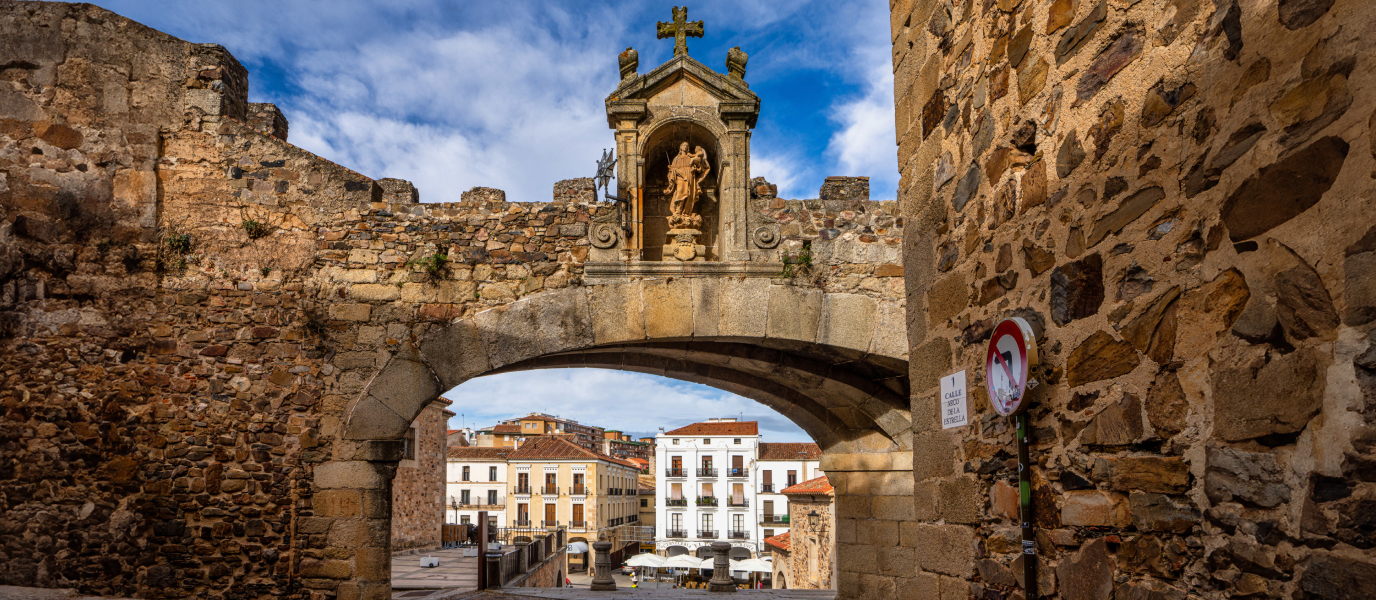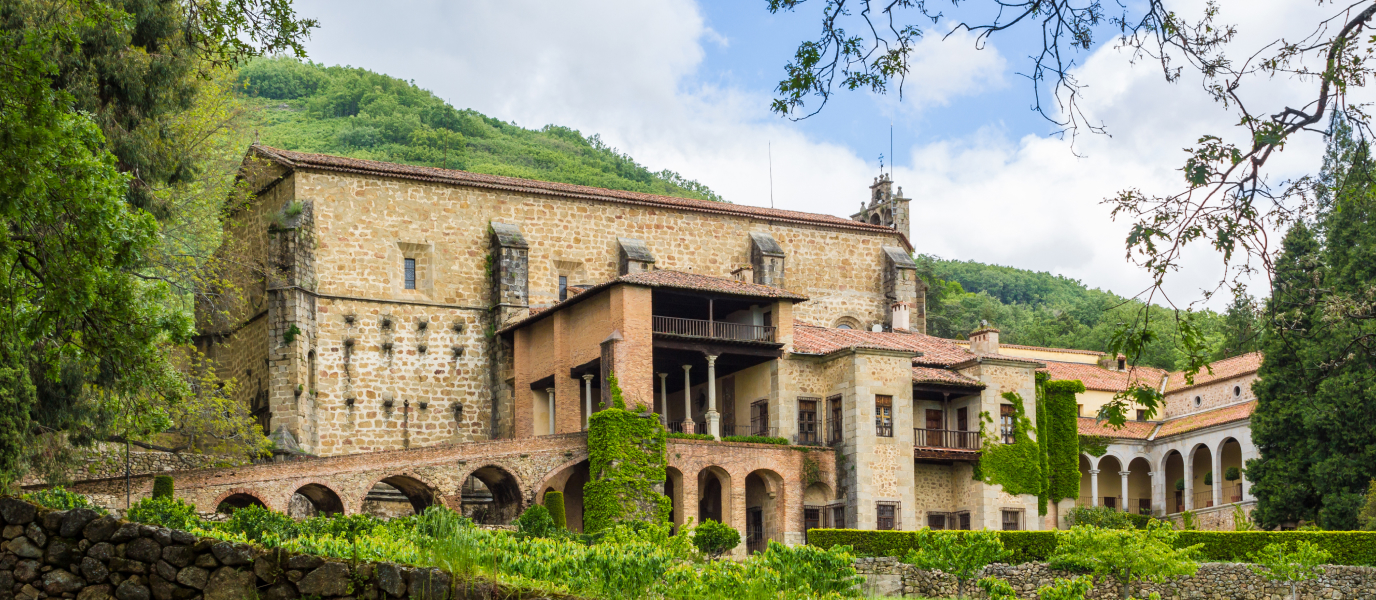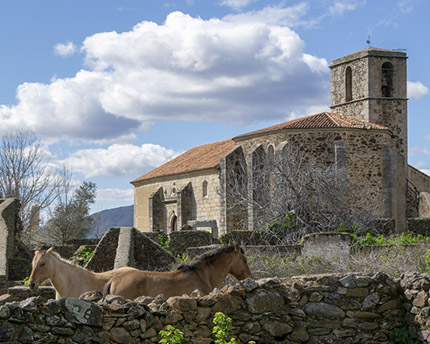The walled city of medieval Cáceres was originally almost impenetrable. The nobility and the clergy gradually withdrew inside the walls, while outside social and commercial life thrived around the Plaza Mayor. An opening was carved in the wall of Cáceres to link the city’s new prospering economic hub with the influential old centre of medieval Cáceres, which was threatening to collapse from becoming so isolated. This was how the iconic Arco de la Estrella came to be, one of the most famous segmental arches in the world.
This unusual skew archway leads into the intricate maze of streets of the old city and is part of an architectural ensemble formed by the medieval walls, the round Bujaco tower and the adjacent Ermita de La Paz chapel.
Join us on a journey through the history, main architectural styles and interesting facts surrounding the Arco de la Estrella in Cáceres, and the site of which it forms part.
The history behind the Arco de la Estrella in Cáceres
The entrance to the old part of Cáceres from Plaza Mayor was carved out of the wall in the 15th century, and was called Puerta Nueva. The decision came about because at the time the medieval city was living something of a paradox. The upper classes were pursuing speculative activities which had escalated into a race to see which family could own the most properties inside the city walls. The wealthy Jewish community continued to live in the Jewish quarters but the poorer working classes were forced out of the walled city. Economic activity began to thrive in Plaza Mayor which lay outside the wall and which was tediously inaccessible for the nobles who were confined inside.
To protect this new gate that opened up the wall, the Torre de los Púlpitos was built adjacent to it. The arrow slits in the cylindrical turrets on the two front corners can still be a daunting sight for visitors today. In 1477 Queen Isabella I of Castile came to the Puerta Nueva to swear an oath before the fueros – regional code of law –. Her husband, Ferdinand II of Aragón, performed the same act at that very same spot two years later.
As Cáceres gained prominence the Puerta Nueva fell into disuse – improved communications meant that this stretch of the wall seemed increasingly small. In 1726, the perpetual ruler of Cáceres, Bernardino de Carvajal Toledo, gave the order for the Puerta Nueva to be pulled down and commissioned Manuel de Larra Churriguera to build the Arco de la Estrella. Bernardino was not motivated by public interest in improving communications but something more spurious: egotism, pure and simple. He owned the nearby Palacio Moctezuma, a palace next to the Bujaco tower, and the narrow dimensions of the Puerta Nueva meant that his carriage could not access the property.
He asked the council to tackle the project by creating a skew entrance so that his coach could turn left on entering. As it turns out he was actually carving out the legacy of one of the most exquisite and original arches of the Spanish Baroque period.
Arco de la Estrella: an elegant archway in the wall of Cáceres
Faithful to the style that his uncle José Benito had started, Manuel de Larra Churriguera’s Arco de la Estrella was a work of engineering in the Baroque style, with Churrigueresque influences. Bringing dynamism and movement to an element, the arch, that does not offer many possibilities beyond the conventional is a huge challenge. With the Arco de la Estrella Manuel de Larra managed it though, perhaps much to his chagrin, because the constraints of the task were real: a wide entrance allowing carriages to turn. By levelling out the beautiful segmental arch and using a highly original skew vault system he worked a miracle.
The outside of the arch is crowned by the coat of arms of Cáceres that Isabella II bestowed on the city. On the inner face of the arch, there is a beautiful shrine niche holding the image of the Virgen de la Estrella. The small architectural piece also features pilasters, a broken pediment, buttresses and is crowned by pinnacles and a cross. This eminently Baroque sculpture in stone is similar to the sculptures of the Virgin of the era, holding Baby Jesus in her left arm and a sceptre in her right. The figure rests on a base, into which the coat of arms of the Carvajal family – the authors of the work – is carved. A small star-shaped street light next to the image lights it up.
Interesting facts about the Arco de la Estrella
On the outside of the arch there is an epigram to one side that mentions the oaths that the Catholic King and Queen swore to the fueros here. From Plaza Mayor you can enter the old city via a large staircase, which used to be a ramp for the coveted carriages. These days hefty bollards prevent any vehicles from entering.
The original star-shaped street light that illuminates the Virgen de la Estrella is held in place by a gothic wall bracket that is believed to date back to the times of the Puerta Nueva, the first entrance built in the 15th century.
The Torre de los Púlpitos is the only fortification added to the wall of Cáceres when the city was conquered following Muslim domination. It is also the only one that leads directly to a palace inside the walls, via an arch over the parapet which connects to the Palacio de Mayoralgo.
As you walk through the Arco de la Estrella, opposite you will see a narrow street, named after the arch, which takes you to the famous Concatedral de Santa María co-cathedral, all the while under the watchful gaze of the beautiful Virgen de la Estrella sculpture.








































































